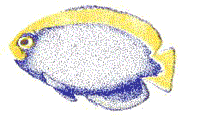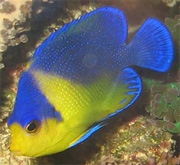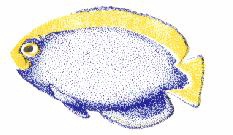|
The Familiar Damsels
By Jim Wolf, Marine Biologist
Of all the fishes in a tropical fish store, the damsel is perhaps the
most approachable. They are hardy, inexpensive and come in a variety of
shapes and sizes. This hardy nature often makes them the fish of choice
to break in a new aquarium. There are about 23 genera of damsels with species
numbering in the hundreds.
The damsel family includes the local state fish, the Garibaldi, and
the symbol of friendly aquarium fishes, the clown fishes. They all eat
a variety of foods, and flake food is a good staple. They do best in well
decorated aquariums for despite their small size they are fiercely territorial.
Groups of one to three of the same species is the rule, since two fish
will result in one constantly terrorizing the other. Even though they are
small do not underestimate their aggression. Avoid placing them with fragile
species and watch for freyed fins, heavy breathing, hiding and other signs
of aggression.
The huge number of damsels makes detailed describtion of them out of
the scope of this paper. Fortunately you can lump them into different categories
for many species are just variations on a theme. Lets look at five of the
major damsel groups seen in the hobby.
Premnas and Amphiprion: The clownfish can all be readily identified
by their conspicuous orange, white and black coloration. Like other damsels
they can change sex as they age, with smaller specimens being males and
the larger female. They breed quite readily in captivity if the water quality
is good. While not mandatory, it is good to put them with an appropriate
species anemone to insure good health and encourage interesting behavior.
Dascyllus: The domino and black and white striped damsels are
both some of the most aggressive and hardy of the damsels. These genera
have a high profile head and enjoy a tank with lots of rocks and crevices.
They are very fast and often infuriate a person trying to get them out
of an aquarium, so avoid using them to cycle a huge aquarium with lots
of hiding places. unless you are willing to spend some time catching them!!
Parma and Abudefduf: These large damsels have a perch like profile,
can grow up to 6 inches, and usually are mildly colored with dark vertical
bars. They adapt readily to flake food, but in the wild they farm algae
by encouraging it to grow on a fiercely defended patch of the reef. Fud-fe-du-ba
is a good bit of trivia (its Abudefduf spelled backwards).
Chromis: The streamlined green damsels are some of the most social
and least aggressive of the damsels behavior. They like to be in small
schools of 5 or more and are planktivores (they enjoy eating small floating
crustaceans such as artemia and mysids).
Chrysiptera: The striking blue damsels are amoung the most intensely
colored of all tropical fishes. They are moderately aggressive and seem
to especially seek out their own kind for aggressive displays. If stressed
out or sleeping they rapidly darken.
|











